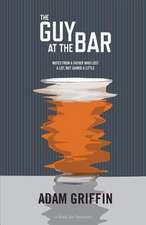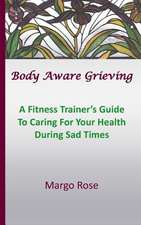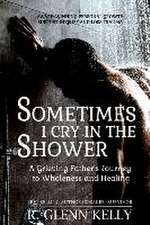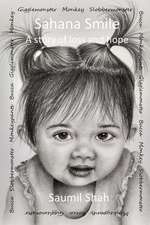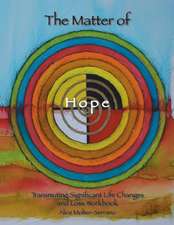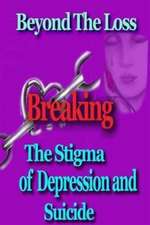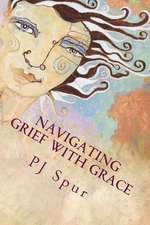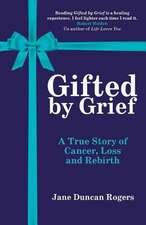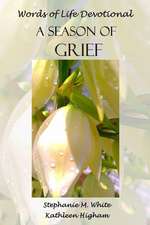The American Book of Living and Dying: Lessons in Healing Spiritual Pain
Autor Richard F. Groves, Henriette A. Klauseren Limba Engleză Paperback – 31 iul 2009
With a compelling new preface, this edition also features an overview of the hospice movement; a survey of Celtic, Tibetan, Egyptian, and other historic perspectives on the sacred art of dying; as well as various therapies, techniques, and rituals to alleviate suffering, stimulate reflection, and strengthen interpersonal bonds. The American Book of Living and Dying gives us courage to trust our deepest instincts, and reminds us that by telling the stories of those who have passed, we remember, honor, and continue to learn from them.
Preț: 107.99 lei
Nou
Puncte Express: 162
Preț estimativ în valută:
20.67€ • 21.50$ • 17.06£
20.67€ • 21.50$ • 17.06£
Carte disponibilă
Livrare economică 24 martie-07 aprilie
Preluare comenzi: 021 569.72.76
Specificații
ISBN-13: 9781587613500
ISBN-10: 1587613506
Pagini: 304
Ilustrații: ONE COLOR
Dimensiuni: 153 x 203 x 21 mm
Greutate: 0.37 kg
Editura: CELESTIAL ARTS
ISBN-10: 1587613506
Pagini: 304
Ilustrații: ONE COLOR
Dimensiuni: 153 x 203 x 21 mm
Greutate: 0.37 kg
Editura: CELESTIAL ARTS
Notă biografică
RICHARD F. GROVES is the founder of the internationally renowned Sacred Art of Living and Dying educational series, which teaches participants how to alleviate spiritual and emotional distress at the end of life. A hospice chaplain for nearly thirty years, Richard has attended the deaths of more than five hundred people. He speaks nine languages and has earned graduate degrees in theology, ethics, law, and pastoral counseling. Richard and his wife, Mary, established the Sacred Art of Living Center in Bend, Oregon, twenty-five years ago, where he still resides today.
HENRIETTE ANNE KLAUSER, Ph.D., is the author of four books, including the best-selling Writing on Both Sides of the Brain and Write It Down, Make It Happen. She is the president of Writing Resources, a seminar and consulting organization, as well as an active lecturer, workshop leader, and freelance writer. Henriette Anne is dedicated to helping people use the power of the written word to build relationships, bring families together, and heal emotional wounds. She lives in Edmonds, Washington.
HENRIETTE ANNE KLAUSER, Ph.D., is the author of four books, including the best-selling Writing on Both Sides of the Brain and Write It Down, Make It Happen. She is the president of Writing Resources, a seminar and consulting organization, as well as an active lecturer, workshop leader, and freelance writer. Henriette Anne is dedicated to helping people use the power of the written word to build relationships, bring families together, and heal emotional wounds. She lives in Edmonds, Washington.
Extras
The Original Hospice: The Art of Dying Well
Apply yourself now, that at the hour of death, you may be glad and unafraid.
–Thomas à Kempis
The word hospice comes from the same root word as the terms hostel and hospitality. Hospice conjures up images of Swiss Alpine shelters, complete with a St. Bernard dog wearing his signature brandy cask. These original hospices were indeed places of respite for weary medieval pilgrims. Like early B & Bs, hospices dotted Europe’s high Alpine landscape, which followed ancient Roman trade routes. Some of the oldest hospices, created by physician-monks and nuns, trace their lineage back to the year 1000 a.d.
The hospice infirmary was an essential part of an institution where travelers also fell sick and died. Within the relatively safe walls of European monastic communities, the West thus created its first hospital and health care system. A library of records still exists that refer to a larger tradition popularly called the ars moriendi, or the art of dying.
Many ancient cultures produced books of the dead. In recent years there has been a revival of interest in writings like the Tibetan Book of the Dying and the Celtic Books of the Dead. Few Americans realize that, a thousand years ago, the West also produced its own book of the dying. At the turn of the last millennium, early in the eleventh century a.d., a convergence of many great traditions took place in the heart of Europe. The result became an ingenious collection of wisdom with the bold name Ars Bene Moriendi, or the Art of Dying Well.
Aspects of this ancient healing art are relevant today. Just knowing that an entire society was once committed to doing whatever it took to support the peaceful dying of its citizens is impressive. The ars sacra moriendi, considered a sacred art because of its care for both body and soul, became a blueprint of the original Western hospice that survived for nearly five hundred years.
Our Western ancestors created guides and manuals for their work, but there was no “one size fits all” model to relieve spiritual pain. During the Middle Ages, there was a distinction between art and science. Science was responsible for finding and applying universal principles; art referred to the application of science to a person or thing. At the end of life, the caregiver’s art was to find a unique way to relieve a particular person’s struggles and fears.
Few places on earth have preserved the spirit of the West’s ancient hospice movement like the medieval town of Beaune (pronounced bone) in Southeastern France.
A Vision from the Past: God’s Hotel
The only measure of a society’s greatness depends upon
how it cares for the poorest of its poor at the end of life.
–Nicholas of Rolin, Founder of l’Hôtel-Dieu
Approaching the village of Beaune today, the modern pilgrim feels dropped into a dream from long ago. Situated in the famous wine-growing region of Burgundy, Beaune is one of Europe’s great trading crossroads. Inside its fortresslike walls is a world-heritage site called l’Hôtel-Dieu, or God’s Hotel.
The Hospices de Beaune was conceived in the mid-fifteenth century, prior to the demise of Europe’s original hospice movement, only a few years after France’s patron saint, Joan of Arc, was burned at the stake. During Europe’s bloody Hundred Years’ War, the lot of the average peasant was desperate. Roving bands of murderers, rapists, and extortionists spread terror throughout the countryside, as one of Europe’s last devastating plagues decimated entire populations. Life and death for the average person was brutish.
In the midst of this despair, the region’s chancellor, Nicolas Rolin, convinced both king and pope to exempt the newly constructed Hotel of God from all taxes in perpetuity. The result is a masterpiece of civic Gothic architecture that rivaled the palaces and cathedrals of its day. Rolin and his wife, Guigone, created a prestigious foundation nicknamed “the palace for the poor.” They employed some of Europe’s great artisans to decorate the roofs with polychrome tiles and emblazon the walls with luxurious Italian tapestries. They commissioned Flemish painters to create one of the best-known altarpieces of the time. Instead of a grim asylum for the dying, this hospice provided luxurious attention for the sick and dying that rivaled the lifestyle of royalty.
Beaune’s extraordinary architectural and artistic achievements are only an external expression of the more important work that was housed within. Inside, a small army of nurses and volunteers tirelessly supported the physical and spiritual well-being of the dying. Word was soon out all over Europe about a new standard in health care at the end of life.
A medieval artist’s rendition of l’Hôtel-Dieu gives a fifteenth-century vision of the end of life with the creative imagination of an entire community at work. The picture’s title, La Grande Salle des Povres en Dimanche Matin, translates as “The Great Hall of the Poor on a Sunday Morning.” This hospice did not serve the privileged nobility of the day; rather, it was dedicated as a hotel for social outcasts.
Architects still marvel that the elegant hospice complex was built over a river, with a glass floor underneath patients’ beds. This unique feature enabled the sick and dying to hear the soothing sound of water, enhancing the environment for patient and caregiver alike. Each private cubicle was furnished with a bed and, more marvelous for the day, clean linens, table settings, a complete apothecary, and aesthetic refinements otherwise available only to royalty.
The artist depicts a flurry of activity, including townspeople providing Sunday brunch, nurses nursing, children playing, musicians singing, and even pets bringing familiarity and solace. The caption could read, “It’s Sunday morning, and where is it happening? At the hospice.”
In the painting there is a liturgical prayer being conducted at the far end of the building, which was unusual for this period. After all, this was not a house of worship but a secular community hospital. Every dimension of caregiving is interconnected. The core belief of this hospice model was that care for the body necessarily involved caring for the soul.
Standing today inside the floodlight grandeur of l’Hôtel-Dieu, you can still sense the spirit that has eluded the modern hospice movement. Looking upward at the ceiling and rafters, in the same line of sight as it was for countless generations of sick, you can read the mantra of the ancient hospice movement: “Ars sacra moriendi, ars sacra vivendi.” The sacred art of dying is the sacred art of living. Here at God’s Hotel is a five hundred-year-old image of the West’s finest hour in caring for the terminally ill. For the fifteenth-century residents of Beaune, the dying were indeed their teachers.
Completed by the year 1491, the Hospices de Beaune is the last great expression of the original Western hospice model. Its legacy endures only because it was built between the years 1441 and 1491. These dates are more than a coincidence of history. The year 1492, well-known to Americans, marks the end of this great hospice movement. Modernity was about to be born, with all of the benefits that surround us on a daily basis, especially those regarding medicine.
By concentrating exclusively on the physical aspects of caregiving, Western medicine would eventually lose its centuries-old instinct concerning other matters at the end of life. Care for the sick and dying would become institutionalized and professionalized, as family, neighbors, and friends abandoned their own inclination to support others at the end of life. The notion of diagnosing and addressing spiritual pain would become disassociated from the treatment of pain and disease. Since 1492, a crisis management model of illness has become the norm in the West.
Our Cultural Bias: Death Is the Enemy
When someone is born we rejoice,
When someone is married we celebrate
But when someone dies, we pretend that nothing happened.
–Margaret Mead
Native Americans and Christopher Columbus discovered each other in 1492. A few years later, a Spanish conquistador by the name of Cabeza de Vaca wrote a letter to the King of Spain with this observation:
Here [in the New World] the ability to heal is still in the hands of the ailing. Being Europeans we thought we had given away to doctors and priests the ability to heal.
This same letter describes how indigenous peoples treated the dying person. There is a hint here about Europe’s shift away from the classical ars moriendi, no longer connecting body, mind, and spirit. A radical change in perspective about something as important as death and dying does not happen overnight. Over the course of five hundred years, cultural beliefs become as familiar as the air we breathe.
A hundred years ago Sigmund Freud questioned whether our so-called civilized attitude about death was not a step backward in evolution, causing us to live psychologically beyond our means. More recently the Pulitzer Prize winner Ernest Becker wrote a challenging and prophetic book, The Denial of Death, an insightful study of our contemporary views. Becker analyzed the American phenomenon of the “disappearance of the fear of death” in terms of psychological repression. The apparent denial at the time of death does not mean that we have become fearless about it; rather, it is proof of how effective the power of repression is.
We are all going to die. The human predilection prefers to keep death at arm’s length, but no amount of denial can change the inevitable. Bioethicist Daniel Callahan suggests that we have built our medical models on two unquestioned social convictions. First, we have an exaggerated sense of individualism that includes the need to control every aspect of how we live and die. Second, we believe that nature can be brought under human domination and made to do what we want it to do.
The Western perspective on death and dying is the direct result of a medical model that considers death to be the enemy. Science has godlike powers; the cure is within our grasp. It is only a matter of more time and resources. Our unqualified confidence in science creates the illusion that death is an option. In the third millennium world of health care, there is little room for the Angel of Death.
We are beginning to realize the limits of medical progress. The challenge is to strike a balance between the rewards of modern medicine and the human and spiritual context of illness. The goal is to support the chronically and terminally ill in living each day with as much meaning as possible. Our ancestors knew that treating spiritual pain at the end of life was as imperative as treating physical suffering. When spiritual suffering was relieved, physical pain decreased. Meaning, hope, relatedness, and forgiveness were as significant in the dying process as managing disease-related symptoms.
The American Book of Living and Dying accesses a legacy that has brought peace and comfort to generations before us. We may not be able to construct the elaborate hospice buildings of our ancestors, yet a contemporary version of their vision may be emerging.
Hospice in America: Gift and Challenge
Spiritual care is not an optional extra for the dying.
–Cicely Saunders
About forty years ago, the phenomenon of the modern hospice movement swept onto the American landscape with lightning speed. Most communities in the United States were about to benefit from the extraordinary work of an English pioneer and physician, Dame Cicely Saunders. In 1967, Dame Saunders established St. Christopher’s Hospice in London, challenging the perception that people had to die in agony. As a result of her vision, the modern hospice movement created a realistic hope for a future in which nobody has to die alone or with pain untreated.
Dr. Saunders approaches what she calls Total Pain Management from a psychospiritual perspective, advocating understanding the context of a patient’s distress. A bonus is that alleviating emotional and spiritual suffering saves money–good news for a health care system overburdened by skyrocketing pharmaceutical costs. Astounding and verifiable results of Total Pain Management include a decrease in the voluntary use of analgesics.
Following Dame Cicely’s approach, care can reach hidden places. Total Pain Management includes looking for vital signs that consider not just the disease but the entire sick person, and it encourages activities like the patient narrative. Many nurses know that pain can sometimes disappear after talking about it because the person is taken seriously. Saunders encouraged doctors to lift artificial taboos about the physician’s appropriate scope of treatment and expand their role as caregivers by asking their patients, “How are you within?”
The success of the modern hospice phenomenon in America has been associated with the baby-boomer generation. This generation seems to be taking to heart Carl Jung’s admonition that “Death is as psychologically important as birth . . . and to shrink away from it is both unhealthy and abnormal because it robs the second half of life of meaning and purpose.”
After only one generation, hospice has been well received by the general public. Palliative care services are an essential part of our communities. The genius of the modern hospice movement was the creation of an interdisciplinary team: doctors, nurses, counselors, and chaplains working as partners in creating a patient’s plan of care. But many American hospice workers are frustrated that the management of physical pain and symptoms remains the primary, if not exclusive, focus of care. The challenge for the next generation of hospice workers is to retain sight of Dr. Saunders’s wisdom regarding Total Pain Management.
The realities of bureaucratic regulations and the reluctance of physicians to refer patients to hospice early enough leave the system burdened with impossible expectations. A dramatic decrease in the length of stay (the number of days a person receives hospice care before their death) means that many of the classical tools for addressing spiritual pain are left untried. In many states, patients spend no more than a week in hospice care, whereas our ancestors consciously journeyed for months with the terminally ill.
For all its undeniable gifts, the modern hospice movement is struggling to preserve its soul. Nevertheless, it has already helped create a conscious dying movement in America. Celebrated advocates, such as Elisabeth Kübler-Ross and Stephen Levine, encourage us to contemplate our own death in advance; we reap unexpected benefits for the rest of our lives. By facing your own ultimate death, you learn to deal productively with each change or small death that presents itself throughout your life.
Apply yourself now, that at the hour of death, you may be glad and unafraid.
–Thomas à Kempis
The word hospice comes from the same root word as the terms hostel and hospitality. Hospice conjures up images of Swiss Alpine shelters, complete with a St. Bernard dog wearing his signature brandy cask. These original hospices were indeed places of respite for weary medieval pilgrims. Like early B & Bs, hospices dotted Europe’s high Alpine landscape, which followed ancient Roman trade routes. Some of the oldest hospices, created by physician-monks and nuns, trace their lineage back to the year 1000 a.d.
The hospice infirmary was an essential part of an institution where travelers also fell sick and died. Within the relatively safe walls of European monastic communities, the West thus created its first hospital and health care system. A library of records still exists that refer to a larger tradition popularly called the ars moriendi, or the art of dying.
Many ancient cultures produced books of the dead. In recent years there has been a revival of interest in writings like the Tibetan Book of the Dying and the Celtic Books of the Dead. Few Americans realize that, a thousand years ago, the West also produced its own book of the dying. At the turn of the last millennium, early in the eleventh century a.d., a convergence of many great traditions took place in the heart of Europe. The result became an ingenious collection of wisdom with the bold name Ars Bene Moriendi, or the Art of Dying Well.
Aspects of this ancient healing art are relevant today. Just knowing that an entire society was once committed to doing whatever it took to support the peaceful dying of its citizens is impressive. The ars sacra moriendi, considered a sacred art because of its care for both body and soul, became a blueprint of the original Western hospice that survived for nearly five hundred years.
Our Western ancestors created guides and manuals for their work, but there was no “one size fits all” model to relieve spiritual pain. During the Middle Ages, there was a distinction between art and science. Science was responsible for finding and applying universal principles; art referred to the application of science to a person or thing. At the end of life, the caregiver’s art was to find a unique way to relieve a particular person’s struggles and fears.
Few places on earth have preserved the spirit of the West’s ancient hospice movement like the medieval town of Beaune (pronounced bone) in Southeastern France.
A Vision from the Past: God’s Hotel
The only measure of a society’s greatness depends upon
how it cares for the poorest of its poor at the end of life.
–Nicholas of Rolin, Founder of l’Hôtel-Dieu
Approaching the village of Beaune today, the modern pilgrim feels dropped into a dream from long ago. Situated in the famous wine-growing region of Burgundy, Beaune is one of Europe’s great trading crossroads. Inside its fortresslike walls is a world-heritage site called l’Hôtel-Dieu, or God’s Hotel.
The Hospices de Beaune was conceived in the mid-fifteenth century, prior to the demise of Europe’s original hospice movement, only a few years after France’s patron saint, Joan of Arc, was burned at the stake. During Europe’s bloody Hundred Years’ War, the lot of the average peasant was desperate. Roving bands of murderers, rapists, and extortionists spread terror throughout the countryside, as one of Europe’s last devastating plagues decimated entire populations. Life and death for the average person was brutish.
In the midst of this despair, the region’s chancellor, Nicolas Rolin, convinced both king and pope to exempt the newly constructed Hotel of God from all taxes in perpetuity. The result is a masterpiece of civic Gothic architecture that rivaled the palaces and cathedrals of its day. Rolin and his wife, Guigone, created a prestigious foundation nicknamed “the palace for the poor.” They employed some of Europe’s great artisans to decorate the roofs with polychrome tiles and emblazon the walls with luxurious Italian tapestries. They commissioned Flemish painters to create one of the best-known altarpieces of the time. Instead of a grim asylum for the dying, this hospice provided luxurious attention for the sick and dying that rivaled the lifestyle of royalty.
Beaune’s extraordinary architectural and artistic achievements are only an external expression of the more important work that was housed within. Inside, a small army of nurses and volunteers tirelessly supported the physical and spiritual well-being of the dying. Word was soon out all over Europe about a new standard in health care at the end of life.
A medieval artist’s rendition of l’Hôtel-Dieu gives a fifteenth-century vision of the end of life with the creative imagination of an entire community at work. The picture’s title, La Grande Salle des Povres en Dimanche Matin, translates as “The Great Hall of the Poor on a Sunday Morning.” This hospice did not serve the privileged nobility of the day; rather, it was dedicated as a hotel for social outcasts.
Architects still marvel that the elegant hospice complex was built over a river, with a glass floor underneath patients’ beds. This unique feature enabled the sick and dying to hear the soothing sound of water, enhancing the environment for patient and caregiver alike. Each private cubicle was furnished with a bed and, more marvelous for the day, clean linens, table settings, a complete apothecary, and aesthetic refinements otherwise available only to royalty.
The artist depicts a flurry of activity, including townspeople providing Sunday brunch, nurses nursing, children playing, musicians singing, and even pets bringing familiarity and solace. The caption could read, “It’s Sunday morning, and where is it happening? At the hospice.”
In the painting there is a liturgical prayer being conducted at the far end of the building, which was unusual for this period. After all, this was not a house of worship but a secular community hospital. Every dimension of caregiving is interconnected. The core belief of this hospice model was that care for the body necessarily involved caring for the soul.
Standing today inside the floodlight grandeur of l’Hôtel-Dieu, you can still sense the spirit that has eluded the modern hospice movement. Looking upward at the ceiling and rafters, in the same line of sight as it was for countless generations of sick, you can read the mantra of the ancient hospice movement: “Ars sacra moriendi, ars sacra vivendi.” The sacred art of dying is the sacred art of living. Here at God’s Hotel is a five hundred-year-old image of the West’s finest hour in caring for the terminally ill. For the fifteenth-century residents of Beaune, the dying were indeed their teachers.
Completed by the year 1491, the Hospices de Beaune is the last great expression of the original Western hospice model. Its legacy endures only because it was built between the years 1441 and 1491. These dates are more than a coincidence of history. The year 1492, well-known to Americans, marks the end of this great hospice movement. Modernity was about to be born, with all of the benefits that surround us on a daily basis, especially those regarding medicine.
By concentrating exclusively on the physical aspects of caregiving, Western medicine would eventually lose its centuries-old instinct concerning other matters at the end of life. Care for the sick and dying would become institutionalized and professionalized, as family, neighbors, and friends abandoned their own inclination to support others at the end of life. The notion of diagnosing and addressing spiritual pain would become disassociated from the treatment of pain and disease. Since 1492, a crisis management model of illness has become the norm in the West.
Our Cultural Bias: Death Is the Enemy
When someone is born we rejoice,
When someone is married we celebrate
But when someone dies, we pretend that nothing happened.
–Margaret Mead
Native Americans and Christopher Columbus discovered each other in 1492. A few years later, a Spanish conquistador by the name of Cabeza de Vaca wrote a letter to the King of Spain with this observation:
Here [in the New World] the ability to heal is still in the hands of the ailing. Being Europeans we thought we had given away to doctors and priests the ability to heal.
This same letter describes how indigenous peoples treated the dying person. There is a hint here about Europe’s shift away from the classical ars moriendi, no longer connecting body, mind, and spirit. A radical change in perspective about something as important as death and dying does not happen overnight. Over the course of five hundred years, cultural beliefs become as familiar as the air we breathe.
A hundred years ago Sigmund Freud questioned whether our so-called civilized attitude about death was not a step backward in evolution, causing us to live psychologically beyond our means. More recently the Pulitzer Prize winner Ernest Becker wrote a challenging and prophetic book, The Denial of Death, an insightful study of our contemporary views. Becker analyzed the American phenomenon of the “disappearance of the fear of death” in terms of psychological repression. The apparent denial at the time of death does not mean that we have become fearless about it; rather, it is proof of how effective the power of repression is.
We are all going to die. The human predilection prefers to keep death at arm’s length, but no amount of denial can change the inevitable. Bioethicist Daniel Callahan suggests that we have built our medical models on two unquestioned social convictions. First, we have an exaggerated sense of individualism that includes the need to control every aspect of how we live and die. Second, we believe that nature can be brought under human domination and made to do what we want it to do.
The Western perspective on death and dying is the direct result of a medical model that considers death to be the enemy. Science has godlike powers; the cure is within our grasp. It is only a matter of more time and resources. Our unqualified confidence in science creates the illusion that death is an option. In the third millennium world of health care, there is little room for the Angel of Death.
We are beginning to realize the limits of medical progress. The challenge is to strike a balance between the rewards of modern medicine and the human and spiritual context of illness. The goal is to support the chronically and terminally ill in living each day with as much meaning as possible. Our ancestors knew that treating spiritual pain at the end of life was as imperative as treating physical suffering. When spiritual suffering was relieved, physical pain decreased. Meaning, hope, relatedness, and forgiveness were as significant in the dying process as managing disease-related symptoms.
The American Book of Living and Dying accesses a legacy that has brought peace and comfort to generations before us. We may not be able to construct the elaborate hospice buildings of our ancestors, yet a contemporary version of their vision may be emerging.
Hospice in America: Gift and Challenge
Spiritual care is not an optional extra for the dying.
–Cicely Saunders
About forty years ago, the phenomenon of the modern hospice movement swept onto the American landscape with lightning speed. Most communities in the United States were about to benefit from the extraordinary work of an English pioneer and physician, Dame Cicely Saunders. In 1967, Dame Saunders established St. Christopher’s Hospice in London, challenging the perception that people had to die in agony. As a result of her vision, the modern hospice movement created a realistic hope for a future in which nobody has to die alone or with pain untreated.
Dr. Saunders approaches what she calls Total Pain Management from a psychospiritual perspective, advocating understanding the context of a patient’s distress. A bonus is that alleviating emotional and spiritual suffering saves money–good news for a health care system overburdened by skyrocketing pharmaceutical costs. Astounding and verifiable results of Total Pain Management include a decrease in the voluntary use of analgesics.
Following Dame Cicely’s approach, care can reach hidden places. Total Pain Management includes looking for vital signs that consider not just the disease but the entire sick person, and it encourages activities like the patient narrative. Many nurses know that pain can sometimes disappear after talking about it because the person is taken seriously. Saunders encouraged doctors to lift artificial taboos about the physician’s appropriate scope of treatment and expand their role as caregivers by asking their patients, “How are you within?”
The success of the modern hospice phenomenon in America has been associated with the baby-boomer generation. This generation seems to be taking to heart Carl Jung’s admonition that “Death is as psychologically important as birth . . . and to shrink away from it is both unhealthy and abnormal because it robs the second half of life of meaning and purpose.”
After only one generation, hospice has been well received by the general public. Palliative care services are an essential part of our communities. The genius of the modern hospice movement was the creation of an interdisciplinary team: doctors, nurses, counselors, and chaplains working as partners in creating a patient’s plan of care. But many American hospice workers are frustrated that the management of physical pain and symptoms remains the primary, if not exclusive, focus of care. The challenge for the next generation of hospice workers is to retain sight of Dr. Saunders’s wisdom regarding Total Pain Management.
The realities of bureaucratic regulations and the reluctance of physicians to refer patients to hospice early enough leave the system burdened with impossible expectations. A dramatic decrease in the length of stay (the number of days a person receives hospice care before their death) means that many of the classical tools for addressing spiritual pain are left untried. In many states, patients spend no more than a week in hospice care, whereas our ancestors consciously journeyed for months with the terminally ill.
For all its undeniable gifts, the modern hospice movement is struggling to preserve its soul. Nevertheless, it has already helped create a conscious dying movement in America. Celebrated advocates, such as Elisabeth Kübler-Ross and Stephen Levine, encourage us to contemplate our own death in advance; we reap unexpected benefits for the rest of our lives. By facing your own ultimate death, you learn to deal productively with each change or small death that presents itself throughout your life.
Recenzii
“Groves and Klauser weave threads of ancient wisdom with stories from real-life experience to create a uniquely American and practical guide for dying well.”
–Ira Byock, M.D., Director of Palliative Care at Dartmouth-Hitchcock Medical Center and author of Dying Well
“This excellent and very readable book finds new ways to create life even out of death. The American Book of Living and Dying opens avenues of healing and hope and shares them with us.”
–Richard Rohr, O.F.M., Founder of the Center for Action and Contemplationand author of Simplicity: The Freedom of Letting Go
–Ira Byock, M.D., Director of Palliative Care at Dartmouth-Hitchcock Medical Center and author of Dying Well
“This excellent and very readable book finds new ways to create life even out of death. The American Book of Living and Dying opens avenues of healing and hope and shares them with us.”
–Richard Rohr, O.F.M., Founder of the Center for Action and Contemplationand author of Simplicity: The Freedom of Letting Go
Cuprins
CONTENTS
Preface to the Paperback Edition - viii
Introduction - 1
Part I. The History
Hospice
The Original Hospice: The Art of Dying Well - 13
A Vision from the Past: God’s Hotel - 14
Our Cultural Bias: Death Is the Enemy - 17
Hospice in America: Gift and Challenge - 19
Ancient Books of the Dead
The Heritage - 21
• Egyptian Book of the Dead: A Greater Light
• Celtic Books of the Dead: Spiritual Midwifery
• Gnostic Books for the Living and Dying: Bridge between East and West
• Tibetan Book of the Dead: Coaching the Soul
• Monastic Books of the Dying: Prescriptive Care
What the Books of the Dead Have in Common: Lessons for Us Today - 34
Spiritual Pain
Pain versus Suffering: The Human Condition - 37
Diagnosing Spiritual Pain: Asking Courageous Questions - 39
Responding to Spiritual Pain: A Psychospiritual Relationship - 42
• Meaning Pain: The Painful-Blissful Encounter with the Truth
• Forgiveness Pain: The Common Cold of Spiritual Pain
• Relatedness Pain: Leaving the Familiar Behind
• Hopelessness Pain: Death as Healer
Becoming an Anamcara - 55
• Ten Commandments for the Anamcara
Part II. The Stories
Annie: the Perfectionist
Will you love me even if I get it wrong? - 63
Henry: the Helper
Will you love me even if I can’t love you back? - 81
Sara: the Achiever
Will you love me even if I am not successful? - 95
Heather: the Dreamer
Will you love me even if you know who I am? - 111
Park: the Thinker
Will you love me even if I lose everything in life? - 125
Maria Elena: the Loyalist
Will you love me even if I break the rules? - 143
Andrew: the Adventurer
Will you love me even if I cry? - 159
Dorothy: the Asserter
Will you love me even if I am weak? - 175
Larry: the Peacemaker
Will you love me even if I disagree with you? - 189
Story Archetypes - 202
Part III. The Tool Chest
Art Therapy - 205
Breath Work - 209
Coma Therapy - 213
Dream Work - 218
Energy Therapies - 223
Forgiveness Exercises - 227
Guided Visualization - 231
Healing and Assistance from Ancestors - 236
Healing Religious Abuse and Images of God - 240
Intercessory (Nonlocal) Prayer - 244
Journaling - 248
Life Review Exercises - 252
Meditation Practices - 257
Music Therapy - 262
Religious Rites and Sacred Writings - 267
Rituals for the Bedside - 270
Rituals of Release - 273
Vigil Rituals and Rituals for Remembering - 277
Bibliography - 285
About the Authors - 294
Preface to the Paperback Edition - viii
Introduction - 1
Part I. The History
Hospice
The Original Hospice: The Art of Dying Well - 13
A Vision from the Past: God’s Hotel - 14
Our Cultural Bias: Death Is the Enemy - 17
Hospice in America: Gift and Challenge - 19
Ancient Books of the Dead
The Heritage - 21
• Egyptian Book of the Dead: A Greater Light
• Celtic Books of the Dead: Spiritual Midwifery
• Gnostic Books for the Living and Dying: Bridge between East and West
• Tibetan Book of the Dead: Coaching the Soul
• Monastic Books of the Dying: Prescriptive Care
What the Books of the Dead Have in Common: Lessons for Us Today - 34
Spiritual Pain
Pain versus Suffering: The Human Condition - 37
Diagnosing Spiritual Pain: Asking Courageous Questions - 39
Responding to Spiritual Pain: A Psychospiritual Relationship - 42
• Meaning Pain: The Painful-Blissful Encounter with the Truth
• Forgiveness Pain: The Common Cold of Spiritual Pain
• Relatedness Pain: Leaving the Familiar Behind
• Hopelessness Pain: Death as Healer
Becoming an Anamcara - 55
• Ten Commandments for the Anamcara
Part II. The Stories
Annie: the Perfectionist
Will you love me even if I get it wrong? - 63
Henry: the Helper
Will you love me even if I can’t love you back? - 81
Sara: the Achiever
Will you love me even if I am not successful? - 95
Heather: the Dreamer
Will you love me even if you know who I am? - 111
Park: the Thinker
Will you love me even if I lose everything in life? - 125
Maria Elena: the Loyalist
Will you love me even if I break the rules? - 143
Andrew: the Adventurer
Will you love me even if I cry? - 159
Dorothy: the Asserter
Will you love me even if I am weak? - 175
Larry: the Peacemaker
Will you love me even if I disagree with you? - 189
Story Archetypes - 202
Part III. The Tool Chest
Art Therapy - 205
Breath Work - 209
Coma Therapy - 213
Dream Work - 218
Energy Therapies - 223
Forgiveness Exercises - 227
Guided Visualization - 231
Healing and Assistance from Ancestors - 236
Healing Religious Abuse and Images of God - 240
Intercessory (Nonlocal) Prayer - 244
Journaling - 248
Life Review Exercises - 252
Meditation Practices - 257
Music Therapy - 262
Religious Rites and Sacred Writings - 267
Rituals for the Bedside - 270
Rituals of Release - 273
Vigil Rituals and Rituals for Remembering - 277
Bibliography - 285
About the Authors - 294



